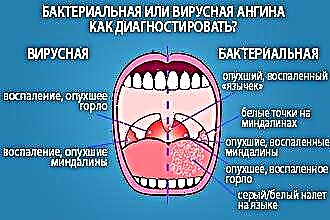Each of us, with the onset of cold weather, tries to dress warmer and wrap ourselves in a scarf to protect the throat from the cold air. The winter period begins in December, although visits to ENT doctors have been increasing since October. To establish the causes of pharyngitis, you need to consult with a specialist.
 To make a diagnosis, instrumental and laboratory methods are used, among which pharyngoscopy, microscopy of smears from the oropharynx and bacterial culture of material collected from the surface of the mucous throat are most often performed. The doctor is also helped by the analysis of complaints and a physical examination, during which sensitive and enlarged regional lymph nodes are revealed due to edema.
To make a diagnosis, instrumental and laboratory methods are used, among which pharyngoscopy, microscopy of smears from the oropharynx and bacterial culture of material collected from the surface of the mucous throat are most often performed. The doctor is also helped by the analysis of complaints and a physical examination, during which sensitive and enlarged regional lymph nodes are revealed due to edema.
Separately, a survey is conducted of the features of the appearance of the first symptoms, the course of the period on the eve of the disease, which helps to suspect the cause of pharyngitis. For example, a person could come into contact with an allergen, drink cold water, communicate with a person with ARVI, or get caught in the rain.
To detect infectious pathogens, blood can be tested by PCR or ELISA. There are many reasons for pharyngitis, but most visits to the otolaryngologist are due to viral infection, although bacteria, fungi and non-infectious factors also play an important role in the development of the disease.
So, we divide all the reasons into two groups:
- infectious, when the cause of the pathology is viruses, bacteria and fungal pathogens;
- non-infectious, which includes all other factors.
Viral pharyngitis
Infection of the body with a virus occurs against the background of a decrease in immune defense. When a person breathes, pathogenic microorganisms as they move along the respiratory tract settle on the mucous membrane, provoking its defeat. It is viruses in 80% of cases that cause inflammation of the oropharynx.
Among the most common viruses, it is worth highlighting adenoviruses, RS infection, enteroviruses, coronaviruses, as well as influenza and parainfluenza viruses. Separately, we single out a group of herpes viruses that provoke the development of herpetic pharyngitis and chickenpox, in which there is a hyperemia of the posterior pharyngeal wall. Of course, the incidence of chickenpox is significantly higher in childhood than in adults.
Infection often occurs through the air through contact with a sick person, sneezing or coughing. Features of the course of the disease with various viral infections:
- Adenovirus infection is characterized by a rapid onset, febrile fever, runny nose, nasal discharge, and sore throat. The cough further irritates the oropharyngeal mucosa, increasing inflammation. Closely located lymph nodes increase and become sensitive to palpation. In addition, there are signs of conjunctivitis (lacrimation, photophobia, redness of the eyes), digestive dysfunction in the form of diarrhea and abdominal pain. With pharyngoscopy, an edematous, hyperemic, sometimes plaque posterior pharyngeal wall is visualized;
- respiratory syncytial infection is manifested by pain when swallowing, runny nose, cough and low-grade fever. A coughing fit ends in thick sputum;
- rhinovirus infection is characterized by a pronounced course from the nose of a mucous nature, a slight dry cough and sore throat. Sometimes lacrimation worries.
Viral pharyngitis can be recognized by soreness, sore throat, discomfort in the throat and additional signs indicating damage to the ENT organs (rhinorrhea). Hyperthermia can reach 39 degrees, but after 2 days it decreases, not exceeding 37.5 degrees.
Stable persistence of fever or its return after a decrease in hyperthermia indicates the addition of a bacterial infection.
Bacterial pharyngitis
 The representative of the bacterial group is streptococcus, staphylococcus, diphtheria bacillus, chlamydia, gonococcus and haemophilus influenzae. Bacterial infection is characterized by a more stable hyperthermia, which remains at a high level until the start of antibiotic therapy or complete sanitation of the infectious focus with antiseptic agents.
The representative of the bacterial group is streptococcus, staphylococcus, diphtheria bacillus, chlamydia, gonococcus and haemophilus influenzae. Bacterial infection is characterized by a more stable hyperthermia, which remains at a high level until the start of antibiotic therapy or complete sanitation of the infectious focus with antiseptic agents.
Symptomatically, the disease manifests itself:
- severe pain when swallowing;
- fever up to 39 degrees;
- malaise;
- decreased appetite.
Without therapy, bacterial inflammation progresses rapidly and spreads to surrounding organs. Due to this, the nasopharynx and larynx are secondarily affected, or an exacerbation of chronic bronchitis or sinusitis is observed.
Sore throat is common in diphtheria. Many organs are affected (eyes, skin, reproductive system), but most of the cases are localized in the oropharynx and larynx.
After infection with a diphtheria bacillus appears:
- severe sore throat;
- severe weakness;
- febrile fever;
- headache;
- pallor of the skin.
 When examining the throat, redness and swelling of the mucous membrane is observed. After two days, fibrinous plaque appears, a pearlescent shade of the mucous membrane, and the tonsils become denser. If you try to remove the films from the mucous membrane, a bleeding surface remains.
When examining the throat, redness and swelling of the mucous membrane is observed. After two days, fibrinous plaque appears, a pearlescent shade of the mucous membrane, and the tonsils become denser. If you try to remove the films from the mucous membrane, a bleeding surface remains.
The inflammation is accompanied by local lymphadenitis. Nearby lymph nodes become painful when palpated and increase in size due to tissue edema.
With timely diagnosis and the introduction of anti-diphtheria serum, plaque does not spread to healthy areas of the mucous membrane and gradually disappear, the temperature returns to normal, and the sore throat decreases.
If the infection progresses, plaque attacks the throat and larynx, increasing the risk of croup. Among the accompanying symptoms of diphtheria, it is worth highlighting the swelling of the neck and shortness of breath.
The development of croup can be seen by a rough, "barking" cough, hoarseness of the voice, which gradually turns into aphonia, shortness of breath and blue skin.
Sore throat can be another cause of bacterial pharyngitis. It develops as a result of infection with streptococcus and its intense reproduction. Clinically, the disease is manifested by severe pain in the oropharynx, which bothers not only when talking or swallowing, but also at night, as a result of which a person cannot sleep.
Fever can reach 39 degrees. With pharyngoscopy, hyperemia of the tonsils and the posterior pharyngeal wall is noted. The picture during the study may vary depending on the form of tonsillitis.
As for gonorrheal pharyngitis, it is characterized by damage to the posterior pharyngeal wall, genitals and urethral canal. Infection occurs when barrier protective devices are not used during intercourse. In addition, infection can occur through the oral-genital route. The disease may not make itself felt for a long time, which predisposes its progression.
The gonorrheal form of sore throat is manifested by:
- dryness in the oropharynx;
- tickling;
- uncomfortable sensations;
- sore throat.
It is quite rare to notice bleeding gums, a change in the timbre of the voice and an unpleasant odor. To establish the cause of pharyngitis in this case, pharyngoscopy and laboratory diagnostics are prescribed. When examining the oropharynx, gray-yellow plaques are found on the edematous, hyperemic mucosa.
Chlamydial pharyngitis is not so common among ENT diseases, but you should not forget about it. Infection occurs through intimacy or contact through shared objects. The symptomatology is not so pronounced, which makes it impossible to make a diagnosis at an early stage of the disease.
A person may be bothered by:
- sore throat;
- soreness when swallowing.
When examining the throat, redness of the mucous membrane is visualized. Chlamydia can be present in the human body, but it does not manifest itself in any way. One has only to slightly decrease the immune defense, as microbes begin to multiply intensively, provoking the appearance of clinical signs.
Fungal pharyngitis
 About a third of all cases of infectious pharyngitis are due to pharyngomycosis, that is, fungal inflammation of the oropharynx. Despite modern diagnostic methods, nevertheless, the disease is often found at the stage of widespread damage to the tongue and gums. Given the fact that a fungal infection appears against the background of reduced immunity, it is often possible to simultaneously identify stomatitis, exacerbation of chronic bronchitis or sinusitis.
About a third of all cases of infectious pharyngitis are due to pharyngomycosis, that is, fungal inflammation of the oropharynx. Despite modern diagnostic methods, nevertheless, the disease is often found at the stage of widespread damage to the tongue and gums. Given the fact that a fungal infection appears against the background of reduced immunity, it is often possible to simultaneously identify stomatitis, exacerbation of chronic bronchitis or sinusitis.
The erased picture of the disease does not allow establishing the cause of pharyngitis at the initial stage of development, therefore, usually an otolaryngologist is consulted in the chronic course of the pathology. Most of the reasons for visiting an ENT doctor are due to the activation of candida fungi.
Candida belongs to the conditionally pathogenic flora of the oropharynx, however, under the influence of certain factors, it becomes the cause of pharyngomycosis.
In less than 10% of cases, fungi of the mold group become the cause of fungal infection. The predisposing factors that trigger the multiplication of a fungal infection include:
- congenital immunodeficiency;
- severe endocrine pathology (thyroid gland dysfunction, diabetes mellitus);
- metabolic disorders (obesity, enzymatic deficiency);
- severe infectious diseases, such as tuberculosis or HIV;
- frequent colds;
- tendency to allergic reactions;
- chemotherapy courses;
- long-term use of hormonal and antibacterial drugs in large doses;
- a chronic infection in the mouth (caries) or oropharynx (tonsillitis);
- systemic autoimmune diseases.
With pharyngoscopy, the mucous membrane of the oropharynx becomes edematous, loose and hyperemic. This is due to the development of an inflammatory reaction in response to the intense multiplication of fungi and cell damage. With an advanced course, the infection can enter the bloodstream, spreading throughout the body. Intoxication is manifested by a slight increase in temperature and malaise. Also worried about dryness, perspiration, burning and soreness in the oropharynx.
When examining the throat on the mucous membrane, you can notice whitish blooms of a curd consistency, which are easily removed from the surface. Note that in some cases, after removing the film, a bleeding zone may remain, which is again covered with plaque the next day.
Chronization of the process predisposes inadequate treatment and late detection of the disease. The variety of pictures with pharyngoscopy depends on the form of the disease:
- the pseudomembranous appearance is characterized by the appearance of a white-yellow plaque against the background of a hyperemic mucosa;
- catarrhal - differs in the formation of areas of hyperemia with a smooth surface;
- the hyperplastic form is manifested by whitish plaques and spots that are difficult to remove from the mucous membrane;
- the erosive-ulcerative type is characterized by the appearance of shallow ulceration and ulcerative defects in the places of penetration of the fungus.
To establish the cause, pharyngoscopy and mycological examination of plaques from the oropharynx are required.
Non-infectious pharyngitis
If we consider non-infectious pharyngitis, its causes include various provoking factors that irritate and damage the mucous membrane of the oropharynx.
These factors include:
- eating very cold drinks or hot food;
- general hypothermia, when, in addition to soreness in the throat, a runny nose may appear;
- deep breathing of cold air, for example, when doing hard work. During nasal breathing, the air is warmed up, which prevents irritation of the mucous membrane. When breathing through the mouth, air enters the throat directly, which narrows the superficial blood vessels, which reduces local protection. All this in combination predisposes the development of inflammation;
- pathology of the digestive tract, for example, gastroesophageal reflux disease, when acidic contents from the stomach are thrown up the esophagus. A person feels heartburn, while the mucous membrane is damaged by the aggressive action of hydrochloric acid;
- traumatic injury. This applies to the period after a diagnostic examination, for example, fibrogastroscopy, after placing a gastric tube or operations on the ENT organs;
 smoker's pharyngitis. It has been observed in people who have been smoking tobacco for over 20 years. The toxic substances formed as a result of the combustion of tobacco have a destructive effect on the mucous membrane of the oropharynx, which makes it dry, hyperemic, provoking sore throat and coughing;
smoker's pharyngitis. It has been observed in people who have been smoking tobacco for over 20 years. The toxic substances formed as a result of the combustion of tobacco have a destructive effect on the mucous membrane of the oropharynx, which makes it dry, hyperemic, provoking sore throat and coughing;- professional pharyngitis. This group includes workers in industries associated with the release of dust particles into the environment (cotton spinning mill, mining industry), as well as aggressive substances (chemical plants, paint and varnish industry). Initially, the pharyngeal mucosa becomes red and edematous, indicating inflammation. Over time, atrophic processes begin to prevail, which lead to the formation of dry crusts and damage to small blood vessels, which is accompanied by the appearance of an admixture of blood in saliva;
- the allergic form is due to the effect on the body of an allergic factor (medicines, perfume aromas, spices, a drink), after which the mucous membrane becomes edematous, a person is worried about perspiration, itching, sore throat, coughing and shortness of breath;
- senile pharyngitis develops as a result of age-related processes, when atrophy of the mucous membrane occurs, through which the blood vessels are visible.
Prophylaxis
Knowing the reasons that can provoke inflammation of the pharynx, you can reduce the risk of illness to a minimum. This requires:
- strengthen immunity (hardening, sports, vitamin therapy);
- eat right and drink enough fluids;
- take time to rest and sleep at least 7 hours a day;
- observe personal hygiene;
- quit smoking and control the use of alcoholic beverages;
- use a disposable mask when dealing with ARVI patients;
- change profession or place of residence;
- be regularly examined by an ENT doctor in the presence of chronic diseases in this area.
There is nothing complicated in the listed recommendations, so you do not need to be lazy and forget about your health. Once the disease is not completely cured, it can turn into a chronic form, gradually affecting the surrounding organs.

 smoker's pharyngitis. It has been observed in people who have been smoking tobacco for over 20 years. The toxic substances formed as a result of the combustion of tobacco have a destructive effect on the mucous membrane of the oropharynx, which makes it dry, hyperemic, provoking sore throat and coughing;
smoker's pharyngitis. It has been observed in people who have been smoking tobacco for over 20 years. The toxic substances formed as a result of the combustion of tobacco have a destructive effect on the mucous membrane of the oropharynx, which makes it dry, hyperemic, provoking sore throat and coughing;

